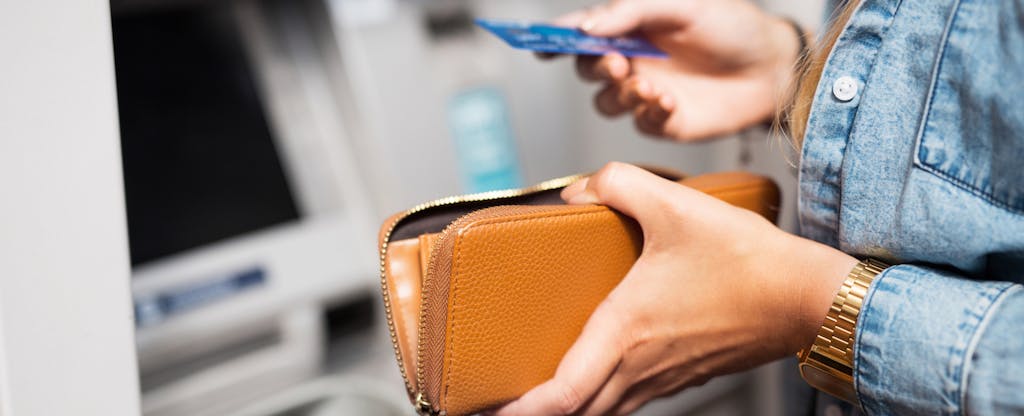In a Nutshell
A cash advance is a short-term loan you can take against the available balance on your credit card. It’s a quick way to get cash, but it can also be expensive. So you might want to consider other ways to borrow money before taking this route.A cash advance is a short-term loan you borrow against the available balance on your credit card.
While a cash advance seems both quick and easy, it can also be expensive — so you should think carefully about whether you really need to spend the money and if a cash advance is the best option for you.
- How does a cash advance work?
- Cash advance terms and fees
- How a cash advance could affect your credit
- Alternatives to a cash advance
- When a cash advance makes sense — and when it doesn’t
How does a cash advance work?
With a cash advance, you’re essentially using the available balance on your credit card to take out a short-term loan. Instead of borrowing money to buy a good or service with your credit card, you’re borrowing cash against your credit limit. Unfortunately, credit card companies don’t treat these two types of transactions the same.
If you buy a good or service with your credit card, the credit card company will charge you the purchase interest rate stated in your contract, usually listed as the purchase APR, or annual percentage rate. And if your card offers a grace period, you won’t start accruing interest on that purchase until your payment is due. That means that as long as your card has a grace period and you pay your balance in full and on time each month, you might never have to pay interest on your purchases.
Cash advances work a little differently though — grace periods typically don’t apply. You’ll start accruing interest on the advanced amount as soon as you take the money out, and your credit card company will likely charge you a higher interest rate for cash advances than it does for normal purchases, plus a processing fee.
The difference between a personal loan and a cash advance
Though a cash advance can work in an emergency, a personal loan could be a cheaper option.
A personal loan allows you to borrow a fixed amount of money that you pay back in installments over a specific period of time. This can help you stick to a budget and get out of debt.
And, often, personal loans have lower interest rates than credit cards.
According to Federal Reserve data for the fourth quarter of 2024, the average APR across all credit card accounts was 21.47%. And cash advances from banks and card issuers typically charge much higher rates than that. On the other hand, for the same period of 2024, Fed data shows that the average APR for a 24-month personal loan was 12.32%.
If you’re looking for fast cash, fees are also worth considering. While you’re typically charged a transaction fee for taking out a cash advance, some personal loans don’t come with fees.
Personal loan amounts vary among lenders but can range from $1,500 up to $100,000. With a secured personal loan, a borrower provides collateral — like a car, for example — that the bank can take if that borrower defaults on the loan. Unsecured loans, on the other hand, don’t require any collateral. Though borrowers with strong credit are more likely to qualify, lenders often view unsecured loans as riskier — and typically charge higher rates for them.
Cash advance terms and fees
Between fees and higher interest rates, cash advances can be costly.
Card issuers typically charge a fee if you use your credit card for a cash advance. This can either be a flat fee per cash advance or a percentage of the loan amount. Depending on the lender, this transaction fee can be as high as 5% of the advance or $10, whichever is greater. For example, if you take out $500 as a cash advance on a card with a 5% cash advance fee, you’ll be charged $25 on top of the $500 loan.
When you use a credit card for a purchase, most lenders give you a grace period to repay the balance before interest starts to accrue. But most credit cards don’t have a grace period for cash advances. Instead, interest charges start accruing as soon as you borrow the money.
If you pull your cash advance from an ATM, you may also face ATM or bank fees, which are separate from the credit card company’s fees. Check with your credit card issuer to find out what ATMs you can use to avoid surcharges.
Before you apply for a credit card, check out its fees, rates and terms, as they may change based on the Prime Rate. Banks and financial institutions that issue credit cards include copies of the card agreement alongside online applications, so review that document first.
For cards you already own, look at your billing statement or credit card agreement. You should find the same disclosures there. If you have further questions, call your credit card company and speak with a representative.
How a cash advance could affect your credit
When you take out a cash advance, you’ll be adding to your credit card debt. If this extra burden increases your credit card utilization (how much of your available credit you’re using), it could hurt your credit scores. As a general rule, you should use less than 30% of your total available credit to keep your credit utilization rate low.
If taking on high-interest debt makes it harder to pay your bills, you could find yourself struggling to make on-time payments. And if you fall behind, your credit could take a hit since payment history is one of the biggest factors in your credit scores.
Beyond the possibility of taking on too much debt and hurting your credit, you should try to avoid getting a cash advance because of the high interest rates and fees.
Alternatives to a cash advance
There are lots of reasons you might need quick-and-easy access to cash, and luckily there are some alternatives to paying the high fees and interest associated with cash advances.
Personal loans
Depending on your credit profile and the type of loan you get, a personal loan could be less expensive than getting a cash advance on your credit card.
Pro: Personal loans generally have a fixed interest rate, fixed term and fixed payments. And you may not need collateral to be approved.
Con: If you don’t have great credit, the annual percentage rate on a personal loan could be about the same or even higher than the APR on a cash advance.
Friends and family
Borrowing money from a friend or family member can be less costly and more flexible than other loan options.
Pro: Informal loans from family or friends, which may not involve any kind of contract, can come with a lower interest rate than a bank would charge.
Con: A broken loan agreement can cause tension with the person who loans you the money.
Payday alternative loans
A payday alternative loan, or PAL, is a short-term, small loan offered by some federal credit unions.
Pro: PALs typically have much lower fees and annual percentage rates than traditional payday loans.
Con: You’ll need to be a credit union member for at least a month if you’re applying for a traditional payday alternative loan.
‘Get-paid-early’ apps
These cash advance apps allow you to borrow a portion of your next paycheck before payday.
Pro: Many of these apps don’t charge interest.
Con: They can include fees such as monthly memberships.
Request a paycheck advance
You may be able to get a cash advance from your employer to cover an emergency expense.
Pro: Employers are unlikely to assess fees or charges for a payroll advance.
Con: Your employer may not allow employees to take advances.
When a cash advance makes sense — and when it doesn’t
A cash advance can help you get the funds you need to cover an emergency expense that you can’t charge to your credit card.
The only pro of a cash advance is that it provides fast access to cash. On the other hand, you’ll have to pay an upfront fee plus the high interest rate you’ll pay on that advance if you can’t repay it right away.
A cash advance can get you out of a tight financial spot if there are no alternatives, but it’s best to plan ahead to avoid taking one. The high total cost tends to outweigh any benefit.
Next steps
If you’re short on funds, getting a cash advance on your credit card can be a quick and easy solution. But it can be costly. High transaction fees and APRs can add up fast and weigh on your credit health.
But if you decide to get a cash advance, there are some actions you can take to minimize the costs.
First, only borrow what you actually need. The less money you take out, the less you’ll have to pay back in principal and interest.
Next, you’ll want to pay off your loan as quickly as possible. Without a grace period, interest on your cash advance starts to accrue on the same day you get your funds. So the sooner you pay off the loan, the more money you can keep in your pocket.
Remember, it’s a good idea to think of credit card cash advances as a last resort. If you think you have to go that route, paying off what you borrow as quickly as possible will save you a lot of money in the long run.



